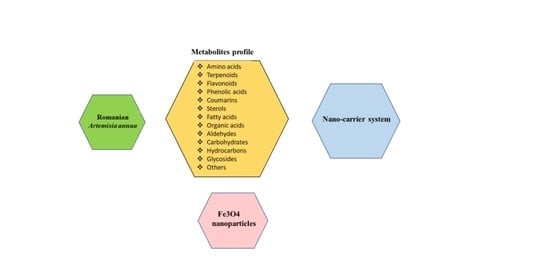Artemisia annua Growing Wild in Romania—A Metabolite Profile Approach to Target a Drug Delivery System Based on Magnetite Nanoparticles
Abstract
:1. Introduction
2. Results and Discussion
2.1. Mass Spectrometry Analysis of Romanian Artemisia annua
2.2. Screening and Classification of the Differential Metabolites
2.3. Nano-Carrier System Based on Magnetic Nanoparticles of Fe3O4
2.4. FT-IR Spectroscopy
2.5. X-ray Diffraction Spectroscopy
2.6. Scanning Electron Microscopy (SEM)
2.7. Magnetic Properties
3. Materials and Methods
3.1. Nano-Carrier System Preparation
3.2. GC-MS Analysis
3.3. Mass Spectrometry
3.4. Identification of Metabolites
3.5. FT-IR Spectroscopy
3.6. XRD Spectroscopy
3.7. Scanning Electronic Microscopy (SEM)
3.8. Magnetization Experiments
4. Conclusions
Author Contributions
Funding
Institutional Review Board Statement
Informed Consent Statement
Data Availability Statement
Acknowledgments
Conflicts of Interest
References
- Dihoru, G.; Boruz, V. The List of Main Spontaneous Medicinal Plants from Romania, Annals of the University of Craiova—Agriculture, Montanology, Cadastre Series; XLIV 328; University of Craiova: Craiova, Romania, 2014. [Google Scholar]
- Pantu Zach, C. Plantele Cunoscute de Poporul Roman-Vocabular Botanic Cuprinzand Numirile Romane, Franceze, Germane si Stiintifice; Institutul de Arte Grafice, Ed.; Minerva: Bucuresti, Romania, 1906. [Google Scholar]
- Cântar, I.C.; Dincă, M. Curiosities about the Artemisia Collections from “Alexandru Beldie” Herbarium, Annals of the University of Craiova—Agriculture, Montanology, Cadastre Series; XLIX; University of Craiova: Craiova, Romania, 2019. [Google Scholar]
- Clinciu Radu, R.A.; Zaharia, M.S.; Lungoci, C.; Vodă, A.D.; Nițu, S.; Robu, T. Studies Regarding the Growth Dynamics of Some Species from Artemisia Genus, Annals of the University of Oradea. Fascicle 2017, 29, 29–34. [Google Scholar]
- Stan, R.L.; Sevastre, B.; Ionescu, C.; Olah, N.K.; Vicaș, L.G.; Páll, E.; Moisa, C.; Hanganu, D.; Sevastre-Berghian, A.C.; Andrei, S.; et al. Artemisia Annua L. extract: A new phytoproduct with sod-like and antitumour activity. Farmacia 2020, 68, 812–821. [Google Scholar] [CrossRef]
- Weathers, P.J.; Arsenault, P.R.; Covello, P.S.; McMickle, A.; Teoh, K.H.; Reed, D.W. Artemisinin production in Artemisia annua: Studies in planta and results of a novel delivery method for treating malaria and other neglected diseases. Phytochem. Rev. 2011, 10, 173–183. [Google Scholar] [CrossRef] [PubMed] [Green Version]
- Mamatova, A.S.; Korona-Glowniak, I.; Skalicka-Woźniak, K.; Józefczyk, A.; Wojtanowski, K.K.; Baj, T.; Sakipova, Z.B.; Malm, A. Phytochemical composition of wormwood (Artemisia gmelinii) extracts in respect of their antimicrobial activity. BMC Complement. Altern. Med. 2019, 19, 288. [Google Scholar] [CrossRef] [PubMed]
- Deb, M.; Kumar, D. Chemical composition and bioactivity of the essential oils derived from Artemisia Annua against the red flour beetle. Biosci. Biotech. Res. Asia 2019, 16, 463–476. [Google Scholar] [CrossRef]
- Mesa, L.E.; Lutgen, P.; Velez, I.D.; Segura, A.M.; Robledo, S.M. Artemisia annua L., Potential source of molecules with pharmacological activity in human diseases. Am. J. Phytomed. Clin. Ther. 2015, 3, 436–450. [Google Scholar]
- Iqbal, S.; Younas, U.; Chan, K.W.; Zia-Ul-Haq, M.; Ismail, M. Chemical composition of Artemisia annua L. leaves and antioxidant potential of extracts as a function of extraction solvents. Molecules 2012, 17, 6020–6032. [Google Scholar]
- Nigam, M.; Atanassova, M.; Mishra, A.P.; Pezzani, R.; Devkota, H.P.; Plygun, S.; Salehi, B.; Setzer, W.N.; Sharifi-Rad, J. Bioactive compounds and health benefits of Artemisia species. Nat. Prod. Commun. 2019, 14, 1934578X19850354. [Google Scholar]
- Sadiq, A.; Hayat, M.Q.; Ashraf, M. Ethnopharmacology of Artemisia annua L.: A Review. In Artemisia Annua-Pharmacology and Biotechnology; Aftab, T., Ferreira, J.F.S., Khan, M.M.A., Naeem, M., Eds.; Springer: Berlin/Heidelberg, Germany, 2014; pp. 9–25. [Google Scholar]
- Badshah, S.L.; Ullah, A.; Ahmad, N.; Almarhoon, Z.M.; Mabkhot, Y. Increasing the strength and production of artemisinin and its derivatives. Molecules 2018, 23, 100. [Google Scholar] [CrossRef] [Green Version]
- Septembre-Malaterre, A.; Lalarizo Rakoto, M.; Marodon, C.; Bedoui, Y.; Nakab, J.; Simon, E.; Hoarau, L.; Savriama, S.; Strasberg, D.; Guiraud, P.; et al. Artemisia annua, a traditional plant brought to light. Int. J. Mol. Sci. 2020, 21, 4986. [Google Scholar] [CrossRef]
- Farid-ul-Haq Muhammad Haseeb, M.T.; Hussain, M.A.; Ashraf, M.U.; Naeem-ul-Hassan, M.; Hussain, S.Z.; Hussain, I. A smart drug delivery system based on Artemisia vulgaris hydrogel: Design, on-off switching, and real-time swelling, transit detection, and mechanistic studies. J. Drug Deliv. Sci. Technol. 2020, 58, 101795. [Google Scholar] [CrossRef]
- Li, Z.; Li, Q.; Wu, J.; Wang, M.; Yu, J. Artemisinin and its derivatives as a repurposing anticancer agent: What else do we need to do? Molecules 2016, 21, 1331. [Google Scholar] [CrossRef] [PubMed]
- Shahrajabian, M.H.; Sun, W.; Cheng, Q. Exploring Artemisia annua L., artemisinin and its derivatives, from traditional chinese wonder medicinal science. Not. Bot. Horti Agrobot. Cluj-Napoca 2020, 48, 1719–1741. [Google Scholar] [CrossRef]
- Bilia, A.R.; Santomauro, F.; Sacco, C.; Bergonzi, M.C.; Donato, R. Essential oil of Artemisia annua L.: An Extraordinary component with numerous antimicrobial properties. Evid.-Based Complement. Altern. Med. 2014, 2014, 159819. [Google Scholar] [CrossRef] [Green Version]
- Bora, K.S.; Sharma, A. The genus Artemisia: A comprehensive review. Pharm. Biol. 2011, 49, 101–109. [Google Scholar] [CrossRef] [PubMed] [Green Version]
- Das, S. Artemisia annua (Qinghao): A pharmacological review. Int. J. Pharm. Sci. Res. 2012, 3, 4573–4577. [Google Scholar]
- Numonov, S.; Sharopov, F.; Salimov, A.; Sukhrobov, P.; Atolikshoeva, S.; Safarzoda, R.; Habasi, M.; Aisa, H.A. Assessment of artemisinin contents in selected Artemisia Species from Tajikistan (Central Asia). Medicines 2019, 6, 23. [Google Scholar] [CrossRef] [Green Version]
- Abad, M.J.; Bedoya, L.M.; Apaza, L.; Bermejo, P. The Artemisia L. genus: A review of bioactive essential oils. Molecules 2012, 17, 2542–2566. [Google Scholar] [CrossRef] [Green Version]
- Lang, S.J.; Schmiech, M.; Hafner, S.; Paetz, C.; Steinborn, C.; Huber, R.; El Gaafary, M.; Werner, K.; Schmidt, C.Q.; Syrovets, T.; et al. Antitumor activity of an Artemisia annua herbal preparation and identification of active ingredients. Phytomedicine 2019, 62, 152962. [Google Scholar] [CrossRef]
- World Malaria Report. In 20 Years of Global Progress and Challenges; World Health Organization: Geneva, Switzerland, 2020; ISBN 978-92-4-001579-1.
- Charlie-Silva, I.; Fernandes Fraceto, L.; Ferreira Silva de Melo, N. Progress in nano-drug delivery of artemisinin and its derivatives: Towards to use in immunomodulatory approaches. Artif. Cells Nanomed. Biotechnol. 2018, 46, S611–S620. [Google Scholar] [CrossRef]
- Zhao, Q.; Luan, X.; Zheng, M.; Tian, X.H.; Zhao, J.; Zhang, W.D.; Ma, B.L. Synergistic mechanisms of constituents in herbal extracts during intestinal absorption: Focus on natural occurring nanoparticles. Pharmaceutics 2020, 12, 128. [Google Scholar] [CrossRef] [Green Version]
- Hussein, R.A.; El-Anssary, A.A. Plants Secondary Metabolites: The Key Drivers of the Pharmacological Actions of Medicinal Plants, Herbal Medicine; Builders, P.F., Ed.; IntechOpen Limited: London, UK, 2018. [Google Scholar]
- Tzenkova, R.; Kamenarska, Z.; Draganov, A.; Atanassov, A. Composition of Artemisia annua essential oil obtained from species gowing wild in Bulgaria. Biotechnol. Biotechnol. Equip. 2010, 24, 1833–1835. [Google Scholar] [CrossRef] [Green Version]
- Albaugh, V.L.; Pinzon-Guzman, C.; Barbul, A. Arginine-Dual roles as an onconutrient and immunonutrient. J. Surg. Oncol. 2017, 115, 273–280. [Google Scholar] [CrossRef] [PubMed]
- Sun-Hee, K.; Roszik, J.; Grimm, E.A.; Ekmekcioglu, S. Impact of l-Arginine metabolism on immune response and anticancer immunotherapy. Front. Oncol. 2018, 8, 67. [Google Scholar]
- Chiangjong, W.; Chutipongtanate, S.; Hongeng, S. Anticancer peptide: Physicochemical property, functional aspect and trend in clinical application (Review). Int. J. Oncol. 2020, 57, 678–696. [Google Scholar] [CrossRef] [PubMed]
- Ochkur, A.V.; Kovaleva, A.M.; Kolesnik, Y.S. Amino-acid composition of subgenus Artemisia Herbs. Chem. Nat. Compd. 2013, 49, 589–591. [Google Scholar] [CrossRef]
- Berechet, M.D.; Stelescu, M.D.; Manaila, E.; Craciun, G. Chemical composition of the essential oil of Artemisia absinthium from Romania. Rev. Chim. 2015, 66, 1814–1818. [Google Scholar]
- Moacă, E.A.; Pavel, I.Z.; Danciu, C.; Crăiniceanu, Z.; Minda, D.; Ardelean, F.; Antal, D.S.; Ghiulai, R.; Cioca, A.; Derban, M.; et al. Romanian wormwood (Artemisia absinthium L.): Physicochemical and nutraceutical screening. Molecules 2019, 24, 3087. [Google Scholar] [CrossRef] [Green Version]
- Ivanescu, B.; Vlase, L.; Corciova, A.; Lazar, M.I. Artemisinin evaluation in Romanian Artemisia annua wild plants using a new HPLC/MS method. Nat. Prod. Res. 2011, 25, 716–722. [Google Scholar] [CrossRef]
- Marinas, I.C.; Oprea, E.; Chifiriuc, M.C.; Badea, I.A.; Buleandra, M.; Lazar, V. Chemical composition and antipathogenic activity of Artemisia annua essential oil from Romania. Chem. Biodivers. 2015, 12, 1554–1564. [Google Scholar] [CrossRef]
- Toth, E.T.; Dezso, A.C.; Kapas, A.; Pako, J.; Ichim, M.C. Comparison of chemical composition of Artemisia annua volatile oil from Romania, Chemical composition and antipathogenic activity of Artemisia annua essential oil from Romania. Planta Med. 2011, 77, PL91. [Google Scholar] [CrossRef]
- Ruperti-Repilado, F.J.; Haefliger, S.; Rehm, S.; Zweier, M.; Rentsch, K.M.; Blum, J.; Jetter, A.; Heim MLeuppi-Taegtmeyer, A.; Terracciano, L.; Bernsmeier, C. Danger of herbal tea: A case of acute cholestatic hepatitis due to Artemisia annua tea. Front. Med. 2019, 6, 221. [Google Scholar] [CrossRef] [PubMed] [Green Version]
- Alsanad, S.; Howard, R.; Williamson, E. An assessment of the impact of herb-drug combinations used by cancer patients. BMC Complementary Altern. Med. 2016, 16, 393. [Google Scholar] [CrossRef] [Green Version]
- Fouad, D.; Bachra, Y.; Ayoub, G.; Ouaket, A.; Bennamara, A.; Knouzi, N.; Berrada, M. A Novel Drug Delivery System Based on Nanoparticles of Magnetite Fe3O4 Embedded in an Auto Cross-Linked Chitosan [Online First]; IntechOpen Limited: London, UK, 2020. [Google Scholar]
- Rahman, H.S.; Othman, H.H.; Hammadi, N.I.; Yeap, S.K.; Amin, K.M.; Abdul Samad, N.; Alitheen, N.B. Novel drug delivery systems for loading of natural plant extracts and their biomedical applications. Int. J. Nanomed. 2020, 15, 2439–2483. [Google Scholar] [CrossRef] [Green Version]
- Mohammadi, M.; Pourseyed Aghaei, F. Magnetite Fe3O4 surface as an effective drug delivery system for cancer treatment drugs: Density functional theory study. J. Biomol. Struct. Dyn. 2021, 39, 2798–2805. [Google Scholar] [CrossRef]
- Gómez-Sotomayor, R.; Ahualli, S.; Viota, J.L.; Rudzka, K.; Delgado, Á.V. Iron/Magnetite nano-particles as magnetic delivery systems for antitumor drugs. J. Nanosci. Nanotechnol. 2015, 15, 3507–3514. [Google Scholar] [CrossRef]
- Socoliuc, V.; Peddis, D.; Petrenko, V.I.; Avdeev, M.V.; Susan-Resiga, D.; Szabó, T.; Turcu, R.; Tombácz, E.; Vékás, L. Magnetic nanoparticle systems for nanomedicine-A materials science perspective. Magnetochemistry 2020, 6, 2. [Google Scholar] [CrossRef] [Green Version]
- Aderibigbe, B.A. Design of drug delivery systems containing artemisinin and its derivatives. Molecules 2017, 22, 323. [Google Scholar] [CrossRef] [Green Version]
- Elfawal, M.A.; Towler, M.J.; Reich, N.G.; Golenbock, D.; Weathers, P.J.; Rich, S.M. Dried whole plant Artemisia annua as an antimalarial therapy. PLoS ONE 2012, 7, e52746. [Google Scholar] [CrossRef]
- Chen, J.; Guo, Z.; Wang, H.-B.; Zhou, J.-J.; Zhang, W.-J.; Chen, Q.-W. Multifunctional mesoporous nanoparticles as pH-responsive Fe2+ reservoirs and artemisinin vehicles for synergistic inhibition of tumor growth. Biomaterials 2014, 35, 6498–6507. [Google Scholar] [CrossRef]
- Wang, Y.; Han, Y.; Yang, Y.; Yang, J.; Guo, X.; Zhang, J.; Pan, L.; Xia, G.; Chen, B. Effect of interaction of magnetic nanoparticles of Fe3O4 and artesunate on apoptosis of K562 cells. Int. J. Nanomed. 2011, 6, 1185–1192. [Google Scholar]
- Akbari, M.; Mora, R.; Maaza, M. First principle study of silver nanoparticle interactions with antimalarial drugs extracted from Artemisia annua plant. J. Nanopart. Res. 2020, 22, 331. [Google Scholar] [CrossRef] [PubMed]
- Chen, G.; Wang, S.; Huang, X.; Hong, J.; Du, L.; Zhang, L.; Ye, L. Environmental factors affecting growth and development of Banlangen (Radix Isatidis) in China. Afr. J. Plant Sci. 2015, 9, 421–426. [Google Scholar]
- Pang, Z.; Chen, J.; Wang, T.; Gao, C.; Li, Z.; Guo, L.; Xu, J.; Cheng, Y. Linking plant secondary metabolites and plant microbiomes: A Review. Front. Plant Sci. 2021, 12, 621276. [Google Scholar] [CrossRef] [PubMed]
- Zhang, X.; Zhao, Y.; Guo, L.; Qiu, Z.; Huang, L.; Qu, X. Differences in chemical constituents of Artemisia annua L from different geographical regions in China. PLoS ONE 2017, 12, e0183047. [Google Scholar] [CrossRef] [Green Version]
- Adams, R.P. Identification of Essential Oil Components by Gas Chromatography/Mass Spectroscopy; Allured Publishing Corporation: Carol Stream, IL, USA, 2007. [Google Scholar]
- Segneanu, A.-E.; Grozescu, I.; Cziple, F.; Berki, D.; Damian, D.; Niculite, C.M.; Florea, A.; Leabu, M. Helleborus purpurascens—Amino acid and peptide analysis linked to the chemical and antiproliferative properties of the extracted compounds. Molecules 2015, 20, 22170–22187. [Google Scholar] [CrossRef] [PubMed] [Green Version]
- Phenomenex, E.Z. Faast-Easy Fast Amino Acid Sampling Testing Kit-User Guide; Torrance, CA, USA; Available online: http://www.phenomenex.com (accessed on 12 October 2021).
- Czechowski, T.; Rinaldi, M.A.; Toyin, F.M.; Van Veelen, M.; Larson, T.R.; Thilo, W.; Rathbone, D.A.; David, H.; Horrocks, P.; Graham, I.A. Flavonoid versus artemisinin anti-malarial activity in Artemisia annua whole-leaf extracts. Front. Plant Sci. 2019, 10, 984. [Google Scholar] [CrossRef] [PubMed] [Green Version]
- Ferreira, J.F.S.; Luthria, D.L.; Sasaki, T.; Heyerick, A. Flavonoids from Artemisia annua L. as antioxidants and their potential synergism with artemisinin against malaria and cancer. Molecules 2010, 15, 3135–3170. [Google Scholar] [PubMed] [Green Version]
- Silveira de Almeida, L.M.; Soares Aleixo de Carvalho, L.; Gazolla, M.C.; Silva Pinto, P.L.; Nascimento da Silva, M.P.; de Moraes, J.; Da Silva Filho, A.A. Flavonoids and sesquiterpene lactones from Artemisia absinthium and Tanacetum parthenium against Schistosoma mansoni worms. Evid.-Based Complement. Altern. Med. 2016, 2016, 9521349. [Google Scholar]
- Baraldi, R.; Isacchi, B.; Predieri, S.; Marconi, G.; Vincieri, F.F.; Bilia, A.R. Distribution of artemisinin and bioactive flavonoids from Artemisia annua L. during plant growth. Biochem. Syst. Ecol. 2008, 36, 340–348. [Google Scholar] [CrossRef]
- Chu, Y.; Wang, H.; Chen, J.; Hou, Y. New sesquiterpene and polymethoxy-flavonoids from Artemisia annua L. Phcog. Mag. 2014, 10, 213–216. [Google Scholar] [CrossRef] [Green Version]
- Brisibe, E.A.; Umoren, E.U.; Brisibe, F.; Magalhäes, P.M.; Ferreira, J.F.S.; Luthria, D.; Wu, X.; Prior, R. Nutritional characterisation and antioxidant capacity of different tissues of Artemisia annua L. Food Chem. 2009, 115, 1240–1246. [Google Scholar] [CrossRef]
- Sharopov, F.S.; Salimov, A.; Numonov, S.; Safomuddin, A.; Bakri, M.; Salimov, T.; Setzer, W.N.; Habasi, M. Chemical composition, antioxidant, and antimicrobial activities of the essential oils from Аrtemisia annua L. growing wild in Tajikistan. Nat. Prod. Commun. 2020, 15, 1934578X20927814. [Google Scholar]
- Bhakuni, R.; Jain, D.; Sharma, R.; Kumar, S. Secondary metabolites of Artemisia annua and their biological activity. Curr. Sci. 2001, 80, 35–48. [Google Scholar]
- Yang, S. Phytochemical Studies of Artemisia annua L. Ph.D. Thesis, Department of Pharmacognosy, The School of Pharmacy, The University of London, ProQuest LLC, London, UK, 2017. [Google Scholar]
- Trendafilova, A.; Moujir, L.M.; Sousa, P.M.C.; Seca, A.M.L. Research advances on health effects of edible Artemisia species and some sesquiterpene lactones constituents. Foods 2021, 10, 65. [Google Scholar] [CrossRef] [PubMed]
- Dawood, H.M.; Shawky, E.; Hammoda, H.M.; Metwally, A.M.; Ibrahim, R.S. Chemical constituents from Artemisia annua and Vitex agnus-castus as new aromatase inhibitors: In-vitro and in-silico studies. J. Mex. Chem. Soc. 2020, 64, 316–326. [Google Scholar] [CrossRef]
- Brown, G.D. The biosynthesis of artemisinin (Qinghaosu) and the phytochemistry of Artemisia annua L. (Qinghao). Molecules 2010, 15, 7603–7698. [Google Scholar]
- Nikolova, M.; Gevrenova, R.; Ivancheva, S. High-performance liquid chromatographic separation of surface flavonoid aglycones in Artemisia annua L. and Artemisia vulgaris L. J. Serb. Chem. Soc. 2004, 69, 571–574. [Google Scholar] [CrossRef]
- Nikolova, M. Infraspecific variability in the flavonoid composition of Artemisia vulgaris L. Acta Bot. Croat. 2006, 65, 13–18. [Google Scholar]
- Valant-Vetscheraa, K.M.; Wollenweberb, E. Flavonoid aglycones from the leaf surfaces of some Artemisia spp. (Compositae-Anthemideae). Z. Naturforsch. 1995, 50, 353–357. [Google Scholar] [CrossRef]
- Rodríguez, E.; Carman, N.J.; Vander Velde, G.; McReynolds, J.H.; Mabry, T.J.; Irwin, M.A.; Geissman, T.A. Methoxylated flavonoids from Artemisia. Phytochemistry 1972, 11, 3509–3514. [Google Scholar] [CrossRef]
- Chougouo, R.D.; Nguekeu, Y.M.; Dzoyem, J.P.; Awouafack, M.D.; Kouamouo, J.; Tane, P.; McGaw, L.J.; Eloff, J.N. Anti-inflammatory and acetylcholinesterase activity of extract, fractions and five compounds isolated from the leaves and twigs of Artemisia annua growing in Cameroon. Springerplus 2016, 5, 1525. [Google Scholar] [CrossRef] [PubMed] [Green Version]
- Lieu, E.L.; Nguyen, T.; Rhyne, S.; Kim, J. Amino acids in cancer. Exp. Mol. Med. 2020, 52, 15–30. [Google Scholar] [CrossRef] [PubMed]
- Cox-Georgian, D.; Ramadoss, N.; Dona, C.; Basu, C. Therapeutic and medicinal uses of terpenes. Med. Plants 2019, 12, 333–359. [Google Scholar]
- Fongang Fotsing, Y.S.; Bankeu Kezetas, J.J. Terpenoids as important bioactive constituents of essential oils. In Essential Oils—Bioactive Compounds, New Perspectives and Application; Santana de Oliveira, M., Almeida da Costa, W., Gomes Silva, S., Eds.; IntechOpen Limited: London, UK, 2020; ISBN 978-1-83962-698-2. [Google Scholar]
- Jahangeer, M.; Fatima, R.; Ashiq, M. Therapeutic and biomedical potentialities of terpenoids—A Review. J. Pure Appl. Microbiol. 2021, 15, 471–483. [Google Scholar] [CrossRef]
- Küpeli Akkol, E.; Genç, Y.; Karpuz, B.; Sobarzo-Sánchez, E.; Capasso, R. Coumarins and coumarin-related compounds in pharmacotherapy of cancer. Cancers 2020, 12, 1959. [Google Scholar] [CrossRef]
- João Matos, M.; Santana, L.; Uriarte, E.; Abreu, O.A.; Molina, E.; Guardado Yordi, E. Coumarins—An Important Class of Phytochemicals in Phytochemicals-Isolation, Characterisation and Role in Human Health; Venket Rao, A., Rao, L.G., Eds.; IntechOpen Limited: London, UK, 2015. [Google Scholar]
- Kozłowska, A.; Szostak-Wegierek, D. Flavonoids-food sources and health benefits. Rocz. Panstw. Zakl. Hig. 2014, 65, 79–85. [Google Scholar]
- Panche, A.N.; Diwan, A.D.; Chandra, S.R. Flavonoids: An overview. J. Nutr. Sci. 2016, 5, e47. [Google Scholar] [CrossRef] [Green Version]
- Kozłowska, A.; Szostak-Węgierek, D. Flavonoids–food sources, health benefits, and mechanisms involved. In Bioactive Molecules in Food; Mérillon, J.M., Ramawat, K., Eds.; Reference Series in Phytochemistry; Springer: Cham, Switzerland, 2018. [Google Scholar]
- Kumar, N.; Goel, N. Phenolic acids: Natural versatile molecules with promising therapeutic applications. Biotechnol. Rep. 2019, 24, e00370. [Google Scholar] [CrossRef]
- Minatel, I.O.; Vanz Borges, C.; Ferreira, M.I.; Gomez, H.A.G.; Chen, C.Y.O. Pace Pereira Lima G., Phenolic compounds: Functional properties, impact of processing and bioavailability. In Phenolic Compounds-Biological Activity; Soto-Hernandez, M., Palma-Tenango, M., del Rosario Garcia-Mateos, M., Eds.; IntechOpen Limited: London, UK, 2017. [Google Scholar]
- Salehi, B.; Quispe, C.; Sharifi-Rad, J.; Cruz-Martins, N.; Nigam, M.; Mishra, A.P.; Konovalov, D.A.; Orobinskaya, V.; Abu-Reidah, I.M.; Zam, W.; et al. Phytosterols: From preclinical evidence to potential clinical applications. Front. Pharmacol. 2021, 11, 599959. [Google Scholar] [CrossRef]
- Nagy, K.; Tiuca, I.-D. Importance of Fatty Acids in Physiopathology of Human Body in Fatty Acids; Catala, A., Ed.; IntechOpen Limited: London, UK, 2017. [Google Scholar]
- Kilcoyne, M.; Joshi, L. Carbohydrates in therapeutics. Cardiovasc. Hematol. Agents Med. Chem. 2007, 5, 186–197. [Google Scholar] [CrossRef]
- Singh, D.; Rajput, A.; Bhatia, A.; Kumar, A.; Kaur, H.; Sharma, P.; Kaur, P.; Singh, S.; Attri, S.; Buttar, H.; et al. Plant-based polysaccharides and their health functions. Funct. Foods Health Dis. 2021, 11, 179–200. [Google Scholar]
- Dhama, K.; Karthik, K.; Khandia, R.; Munjal, A.; Tiwari, R.; Rana, R.; Khurana, S.K.; Ullah, S.; Khan, R.U.; Alagawany, M.; et al. Medicinal and therapeutic potential of herbs and plant metabolites/Extracts countering viral pathogens-Current knowledge and future prospects. Curr. Drug Metab. 2018, 19, 236–263. [Google Scholar] [CrossRef] [PubMed]
- Khan, H.; Saeedi, M.; Nabavi, S.; Mubarak, M.; Bishayee, A. Glycosides from medicinal plants as potential anticancer agents: Emerging trends towards future drugs. Curr. Med. Chem. 2018, 26, 2389–2406. [Google Scholar] [CrossRef]
- Mohammed, L.; Gomaa, H.G.; Ragab, D.; Zhu, J. Magnetic nanoparticles for environmental and biomedical applications: A review. Particuology 2017, 30, 1–14. [Google Scholar] [CrossRef]
- Wahajuddin Arora, S. Superparamagnetic iron oxide nanoparticles: Magnetic nanoplatforms as drug carriers. Int. J. Nanomed. 2012, 7, 3445–3471. [Google Scholar] [CrossRef] [Green Version]
- Nunes Oliveira, R.; Cordeiro Mancini, M.; Salles de Oliveira, F.C.; Marques Passos, T.; Quilty, B.; da Silva Moreira Thiré, R.M.; McGuinness, G.B. FTIR analysis and quantification of phenols and flavonoids of five commercially available plants extracts used in wound healing. Matéria 2016, 21, 767–779. [Google Scholar]
- Kristoffersen, K.A.; van Amerongen, A.; Böcker, U.; Lindberg, D.; Wubshet, S.G.; de Vogel-van den Bosch, H.; Horn, S.J.; Afseth, N.K. Fourier-transform infrared spectroscopy for monitoring proteolytic reactions using dry-films treated with trifluoroacetic acid. Sci. Rep. 2020, 10, 7844. [Google Scholar] [CrossRef]
- Ercioglu, E.; Velioglu, H.M.; Boyaci, I.H. Determination of terpenoid contents of aromatic plants using NIRS. Talanta 2018, 178, 716–721. [Google Scholar] [CrossRef]
- Mawa, S.; Jantan, I.; Husain, K. Isolation of terpenoids from the stem of Ficus aurantiaca Griff and their effects on reactive oxygen species production and chemotactic activity of neutrophils. Molecules 2016, 21, 9. [Google Scholar] [CrossRef] [Green Version]
- Sai Prakash Chaturvedula, V.; Mubarak, C.; Prakash, I. IR spectral analysis of diterpene glycosides isolated from Stevia rebaudiana. Food Nutr. Sci. 2012, 3, 1467–1471. [Google Scholar]
- Forfang, K.; Zimmermann, B.; Kosa, G.; Kohler, A.; Shapaval, V. FTIR Spectroscopy for evaluation and monitoring of lipid extraction efficiency for oleaginous fungi. PLoS ONE 2017, 12, e0170611. [Google Scholar] [CrossRef] [PubMed] [Green Version]
- Mehrotra, R. Infrared spectroscopy, gas chromatography/Infrared in food analysis. In Encyclopedia of Analytical Chemistry; Meyers, R.A., Ed.; Wiley: Hoboken, NJ, USA, 2006; ISBN 978047197670. [Google Scholar]
- Iranshahi, M.; Emami, S.A.; Mahmoud-Soltani, M. Detection of sesquiterpene lactones in ten Artemisia species population of Khorasan Provinces. Iran. J. Basic Med Sci. 2007, 10, 183–188. [Google Scholar]
- Limem, S.; Maazaoui, R.; Mani Kongnine, D.; Mokhtar, F.; Karmous, T. Preliminary identification of Citrullus colocynthis from Togo by FT-IR and Raman Spectroscopy. Int. J. Adv. Res. 2015, 3, 354–360. [Google Scholar]
- Segneanu, A.E.; Gozescu, I.; Dabici, A.; Sfirloaga, P.; Szabadai, Z. Organic Compounds FT-IR Spectroscopy in Macro to Nano Spectroscopy; Uddin, J., Ed.; InTechOpen: Rijeka, Croatia, 2012; ISBN 978-953-51-0664-7. [Google Scholar]
- Monallem-Bahont, M.; Bertrand, S.; Pena, O. Synthesis and characterization of Zn1-xNixFe2O4 spinels prepared by a citrate precursor. J. Solid State Chem. 2005, 178, 1080–1086. [Google Scholar] [CrossRef]
- Ahn, Y.; Choi, E.J.; Kim, E.H. Superparamagnetic relaxation in cobalt ferrite nano-particles synthesized from hydroxide carbonate precursors. Rev. Adv. Mater. Sci. 2003, 5, 477–480. [Google Scholar]
- Naseri, M.G.; Saion, E.B.; Hashim, M.; Shaari, A.H.; Ahangar, H.A. Synthesis and characterization of zinc ferrite nanoparticles by a thermal treatment method. Solid State Commun. 2011, 151, 1031–1035. [Google Scholar] [CrossRef]
- Mihalca, I.; Ercuta, A. Structural relaxation in Fe70Cr10.5P11.5Mn1.5C6.5 amorphous alloys. J. Optoelectron. Adv. Mater. 2003, 5, 245–249. [Google Scholar]
- Marin, C.N.; Fannin, P.C.; Malaescu, I. Time solved susceptibility spectra of magnetic fluids. J. Magn. Magn. Mater. 2015, 388, 45–48. [Google Scholar] [CrossRef]
- Fannin, P.C.; Marin, C.N. Determination of the Landau-Lifshitz damping parameter by means of complex susceptibility measurements. J. Magn. Magn. Mater. 2006, 299, 425–429. [Google Scholar] [CrossRef]
- Mălăescu, I.; Marin, C.N. Study of magnetic fluids by means of magnetic spectroscopy. Phys. B Condens. Matter 2005, 365, 134–140. [Google Scholar]
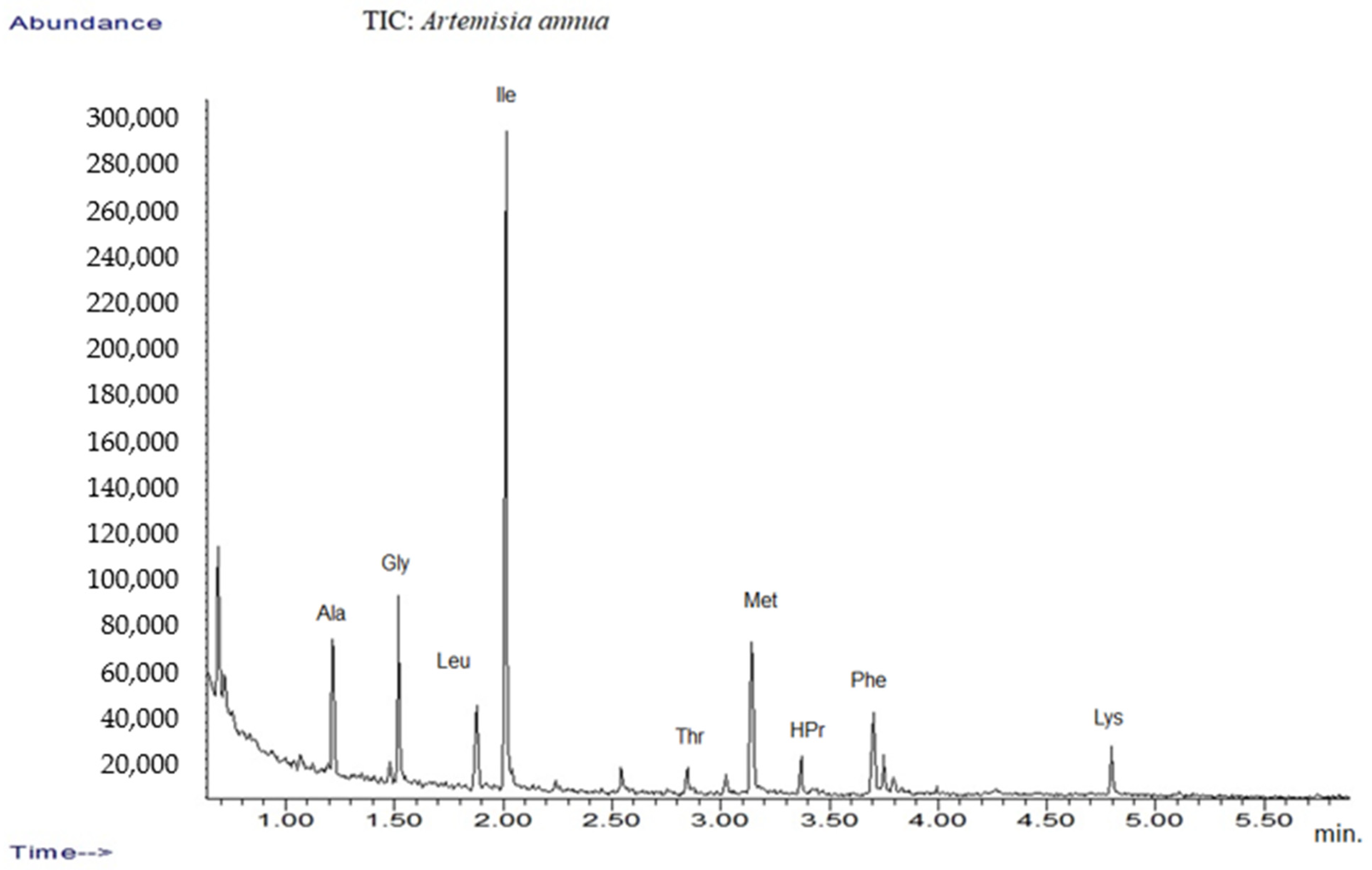

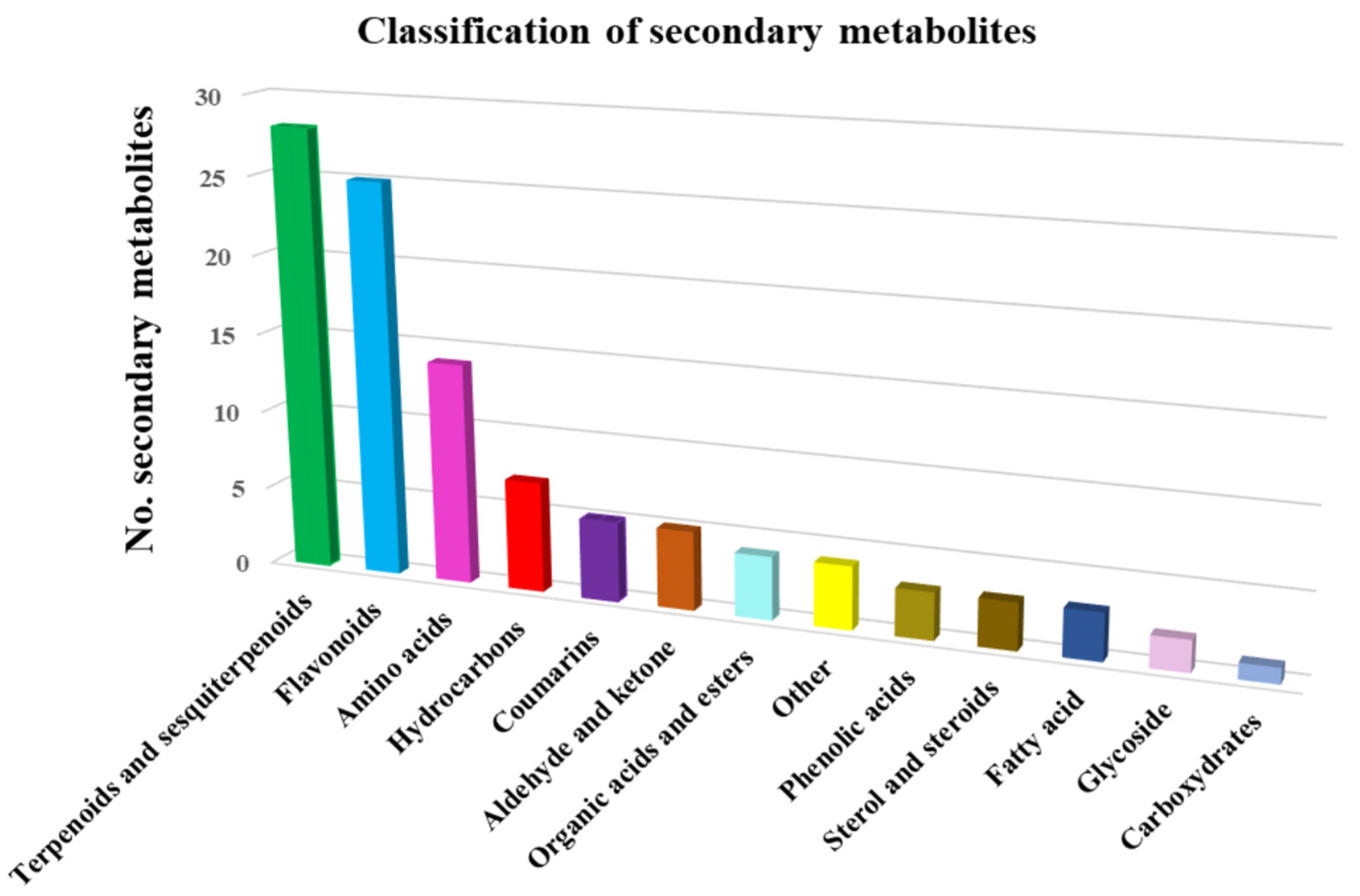
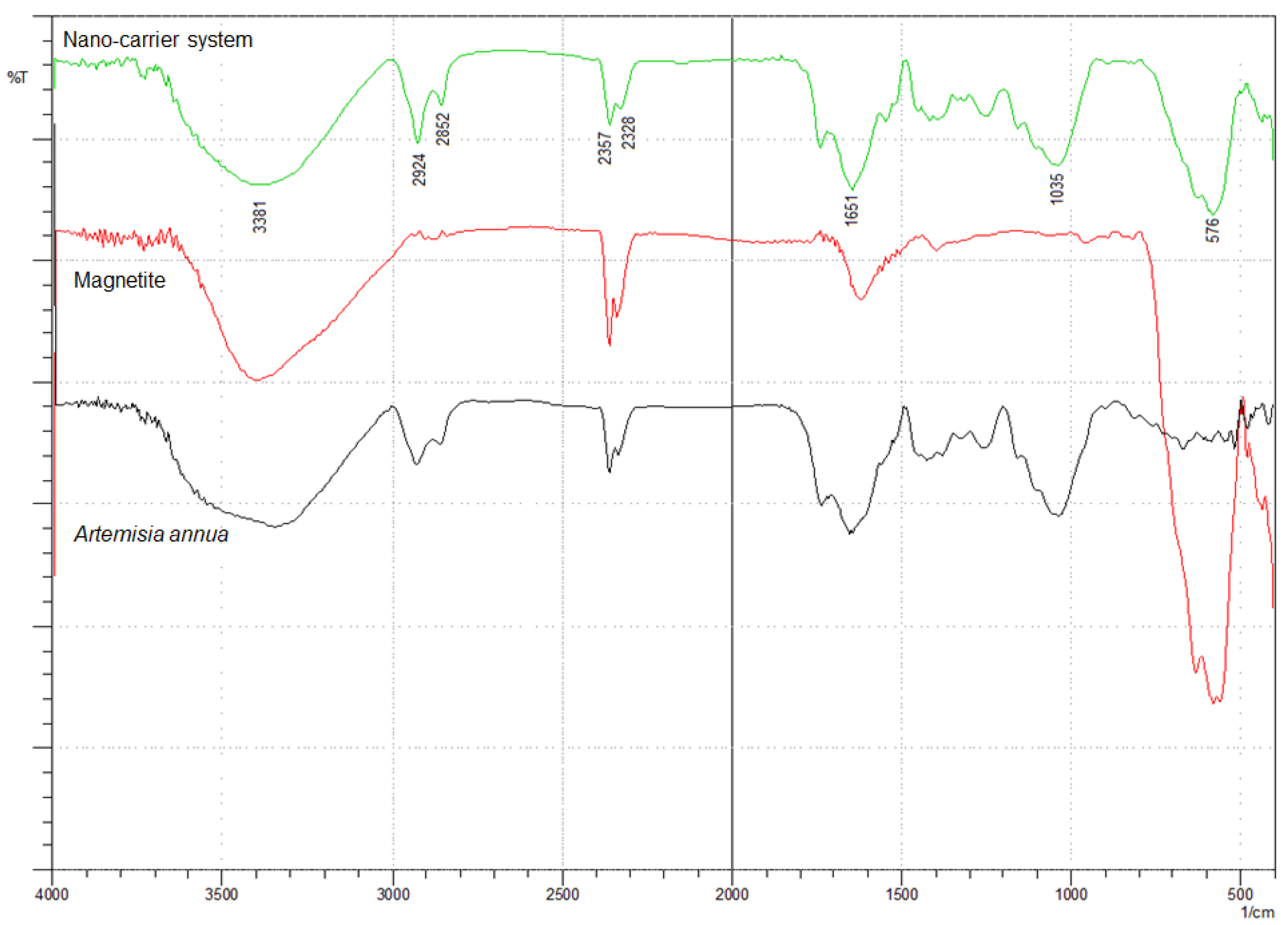
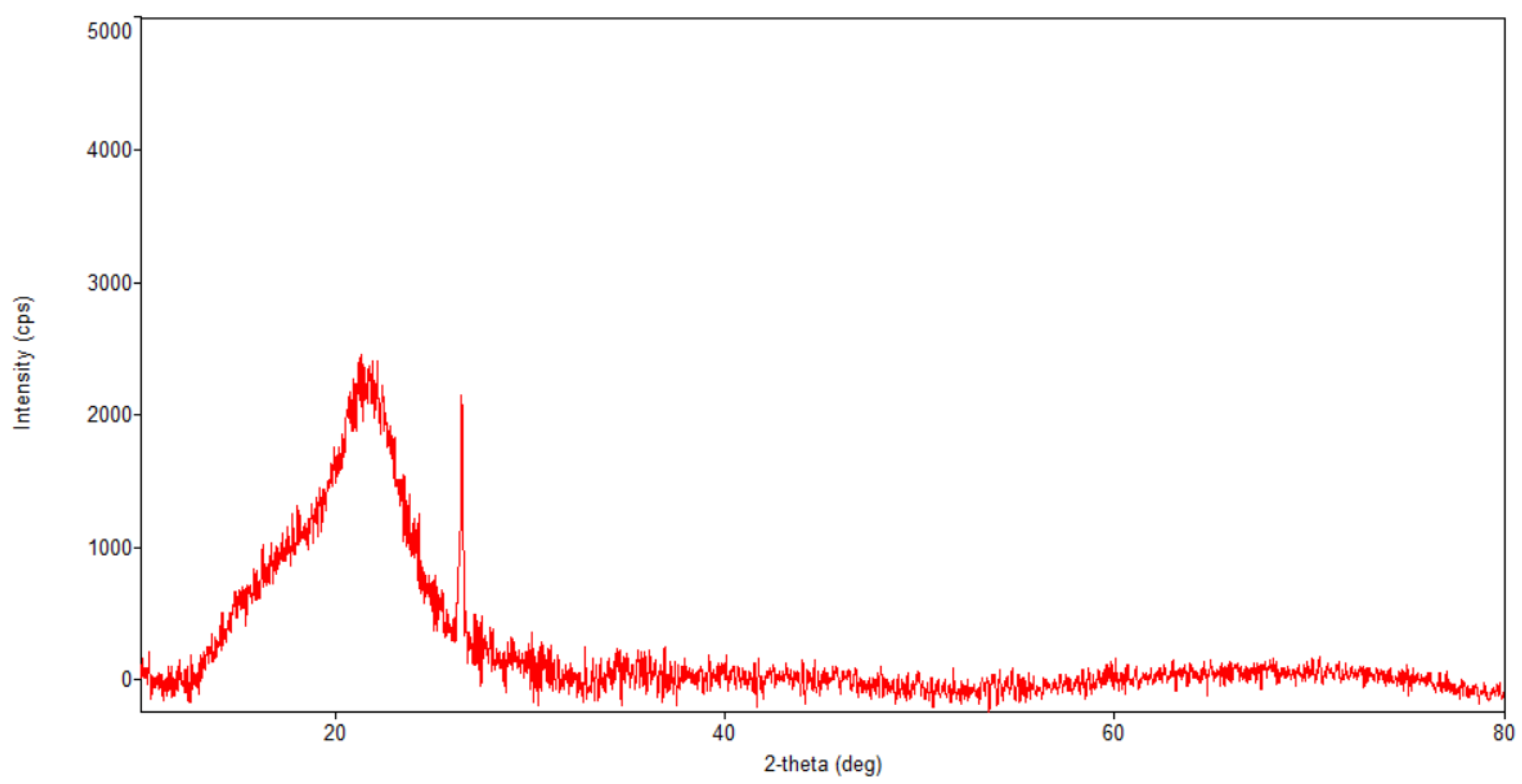
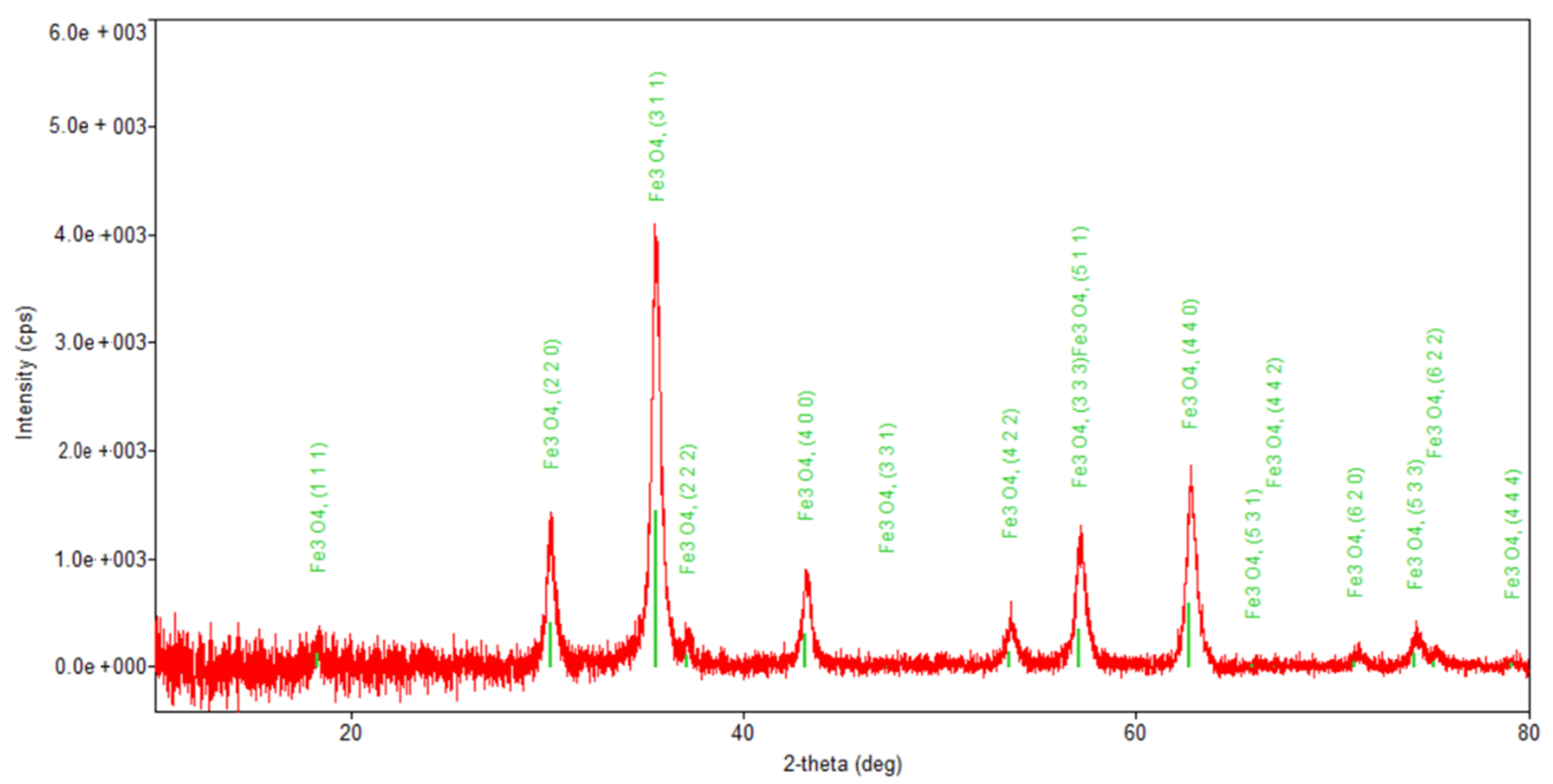
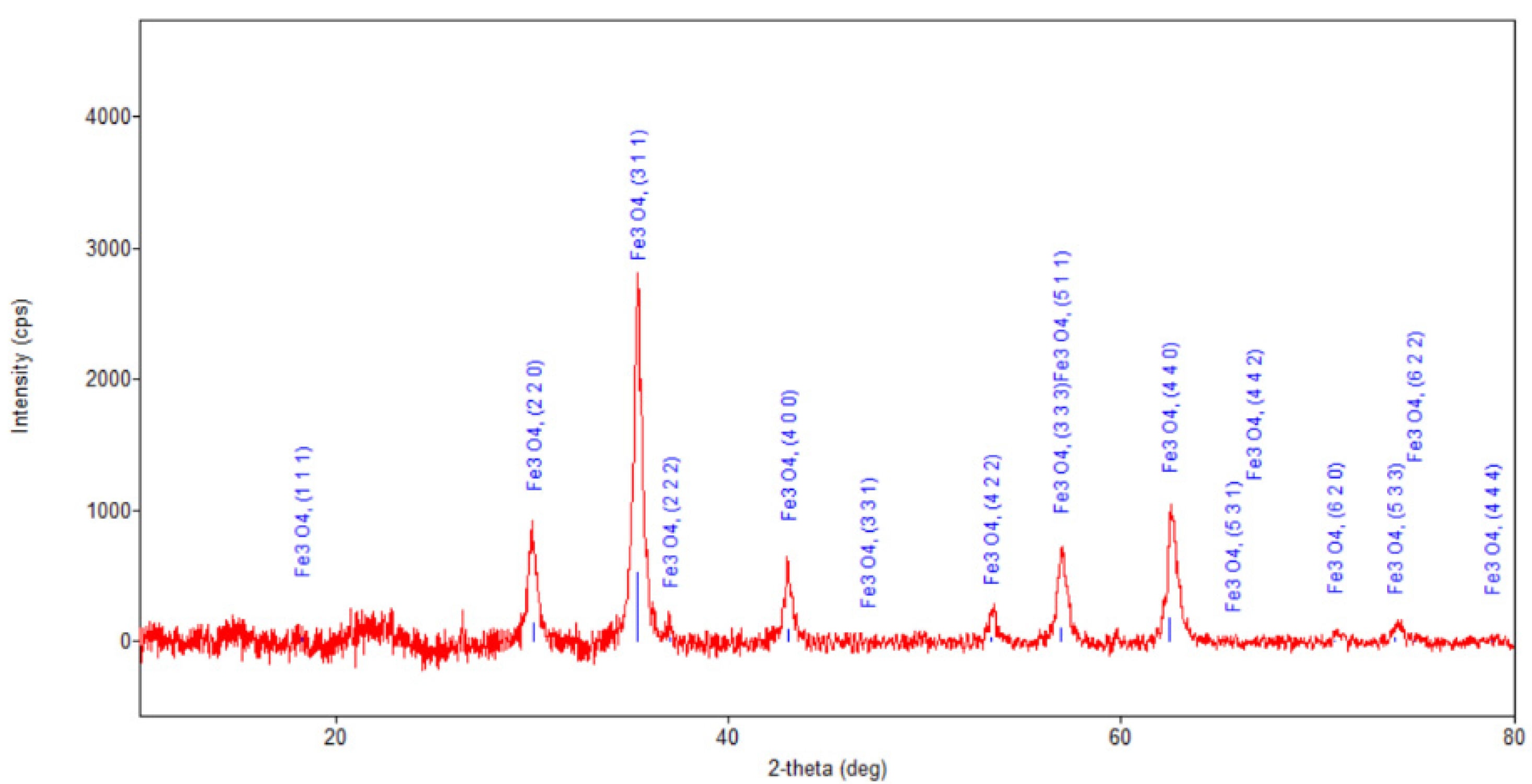
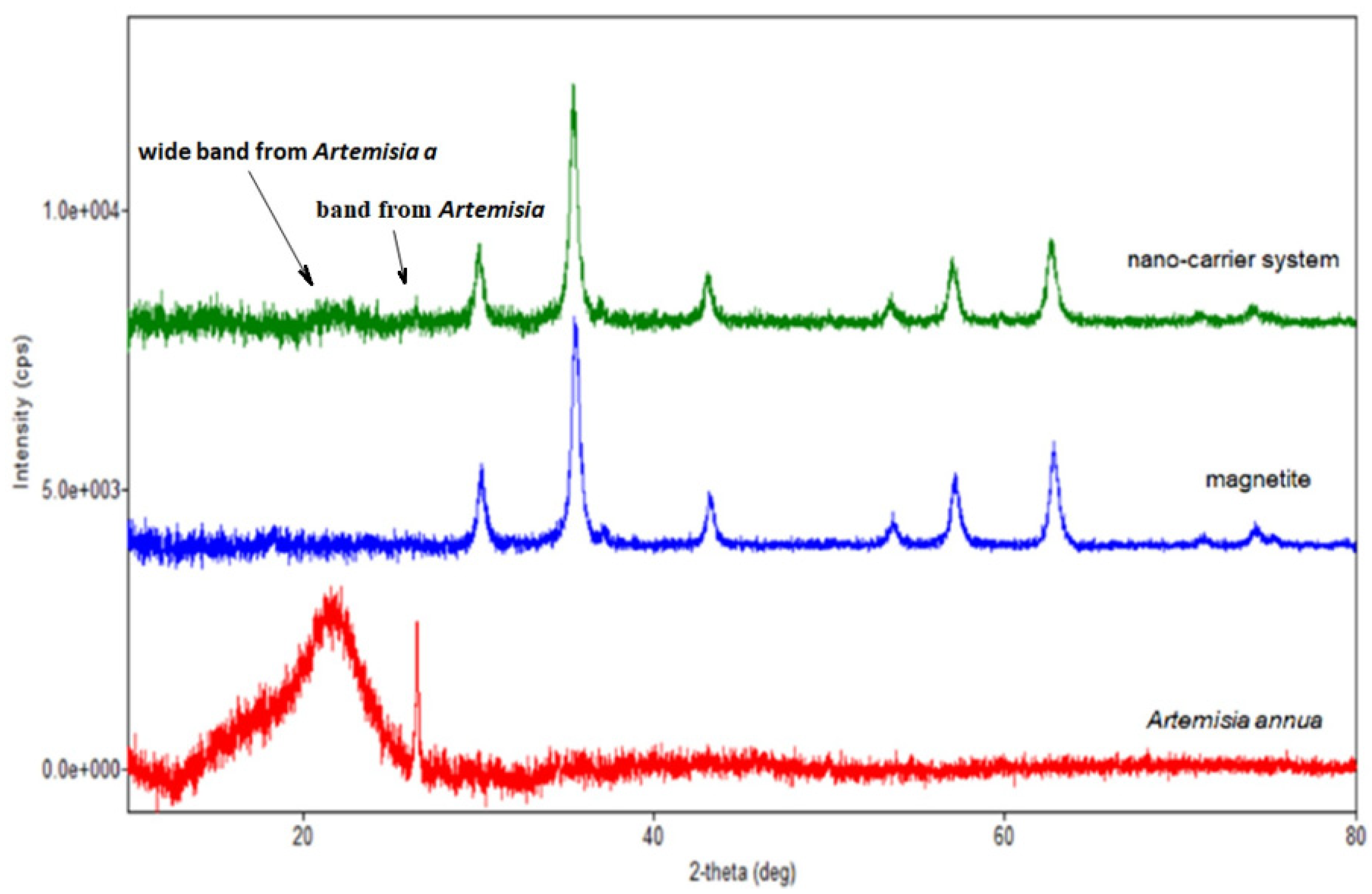
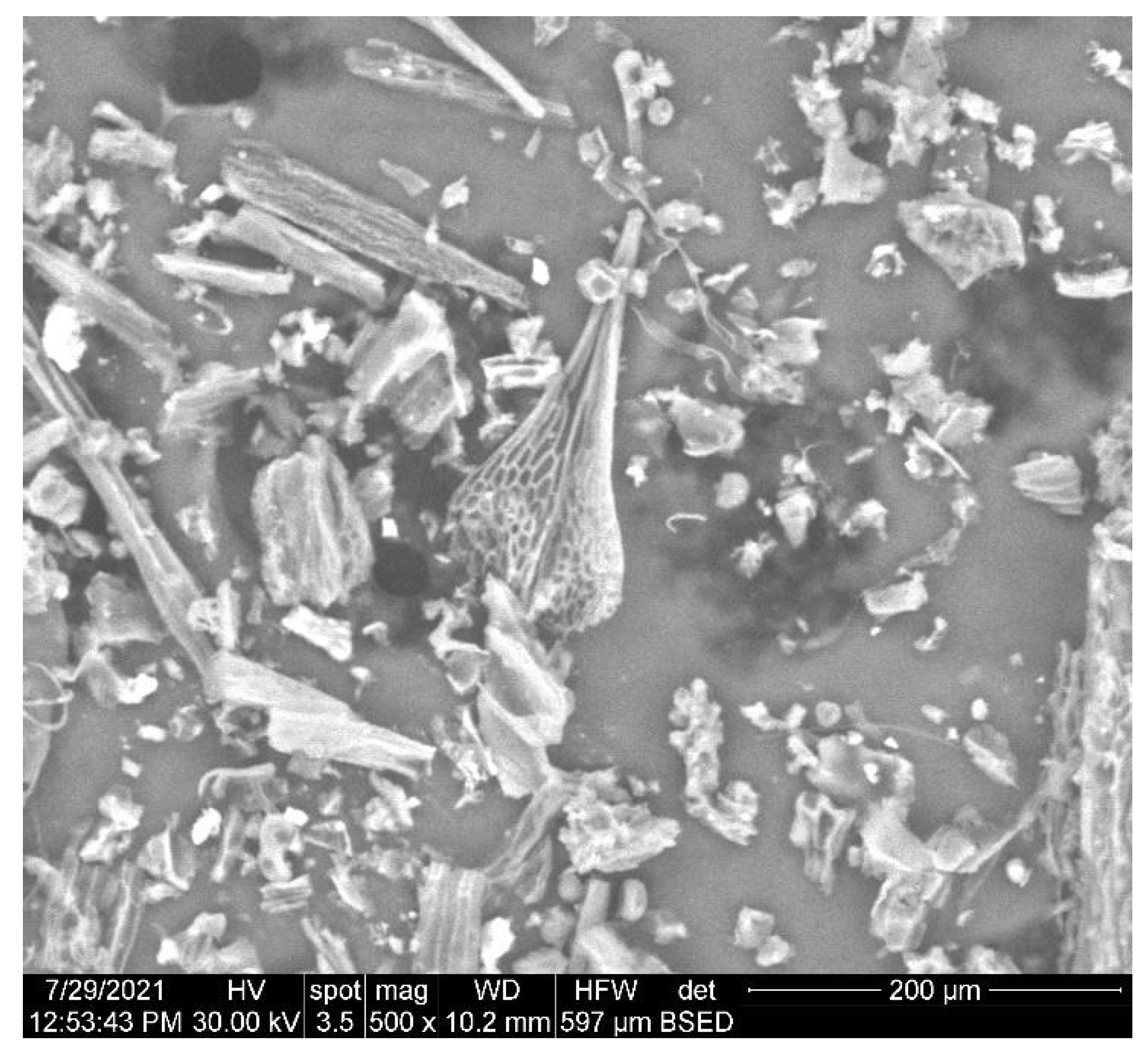
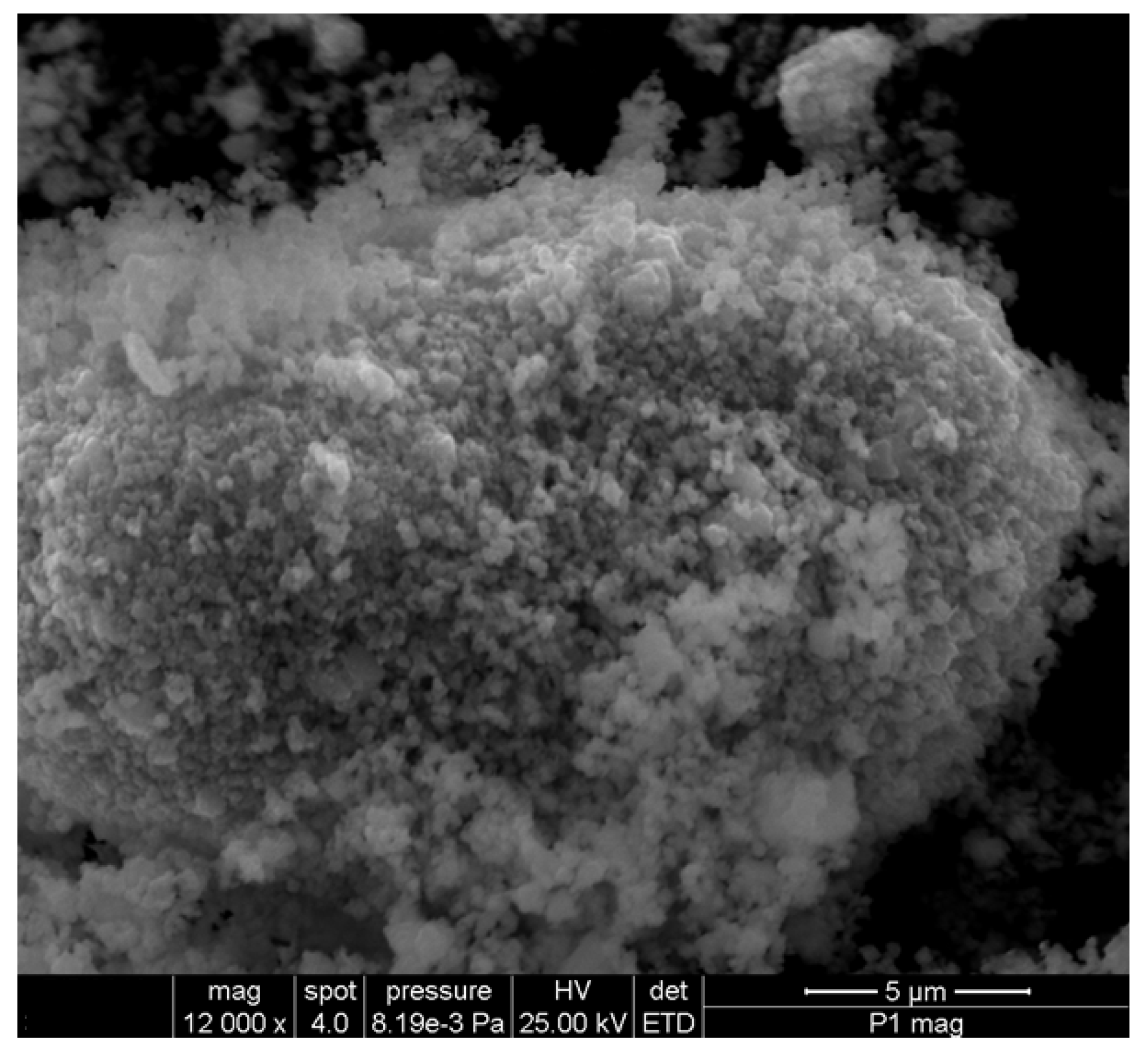
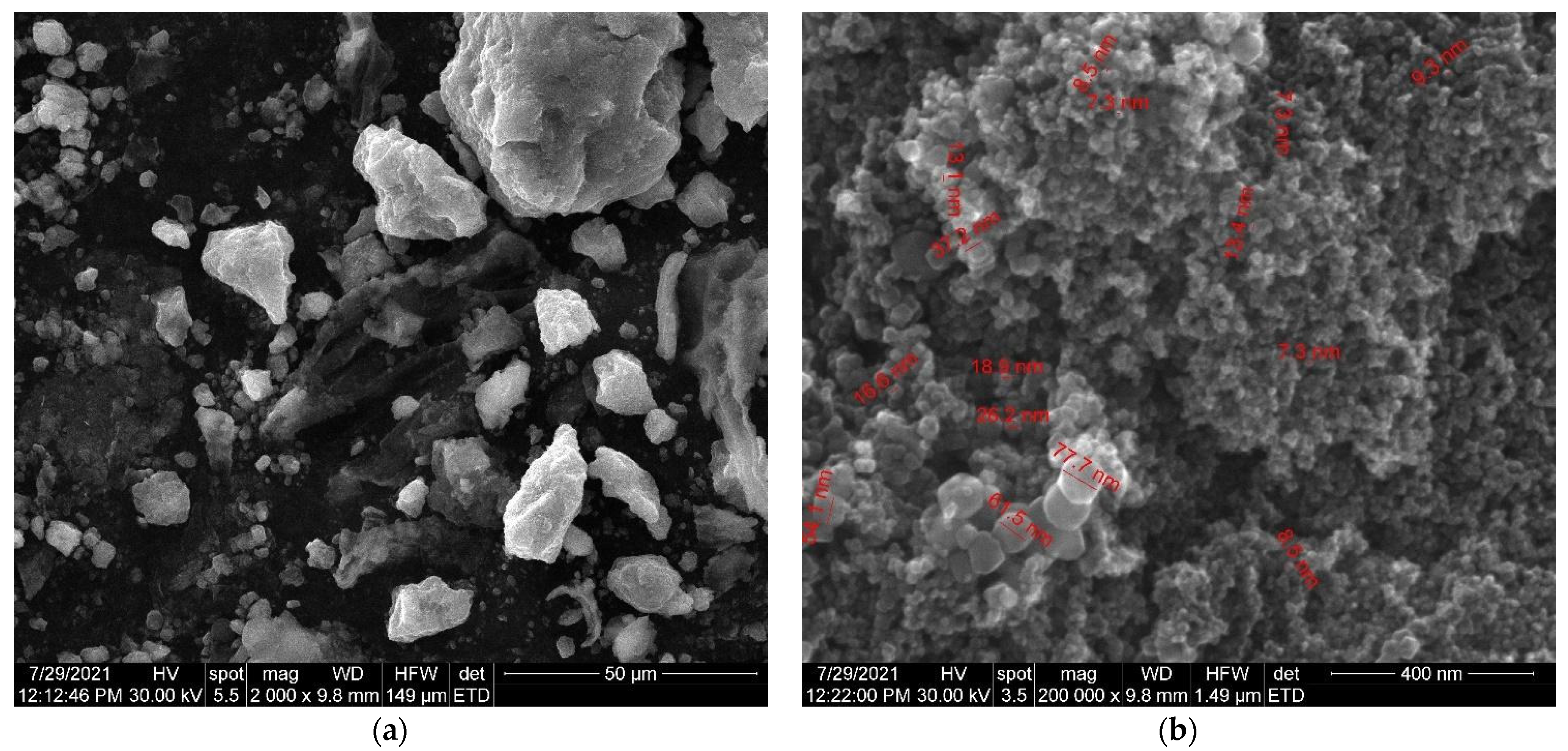
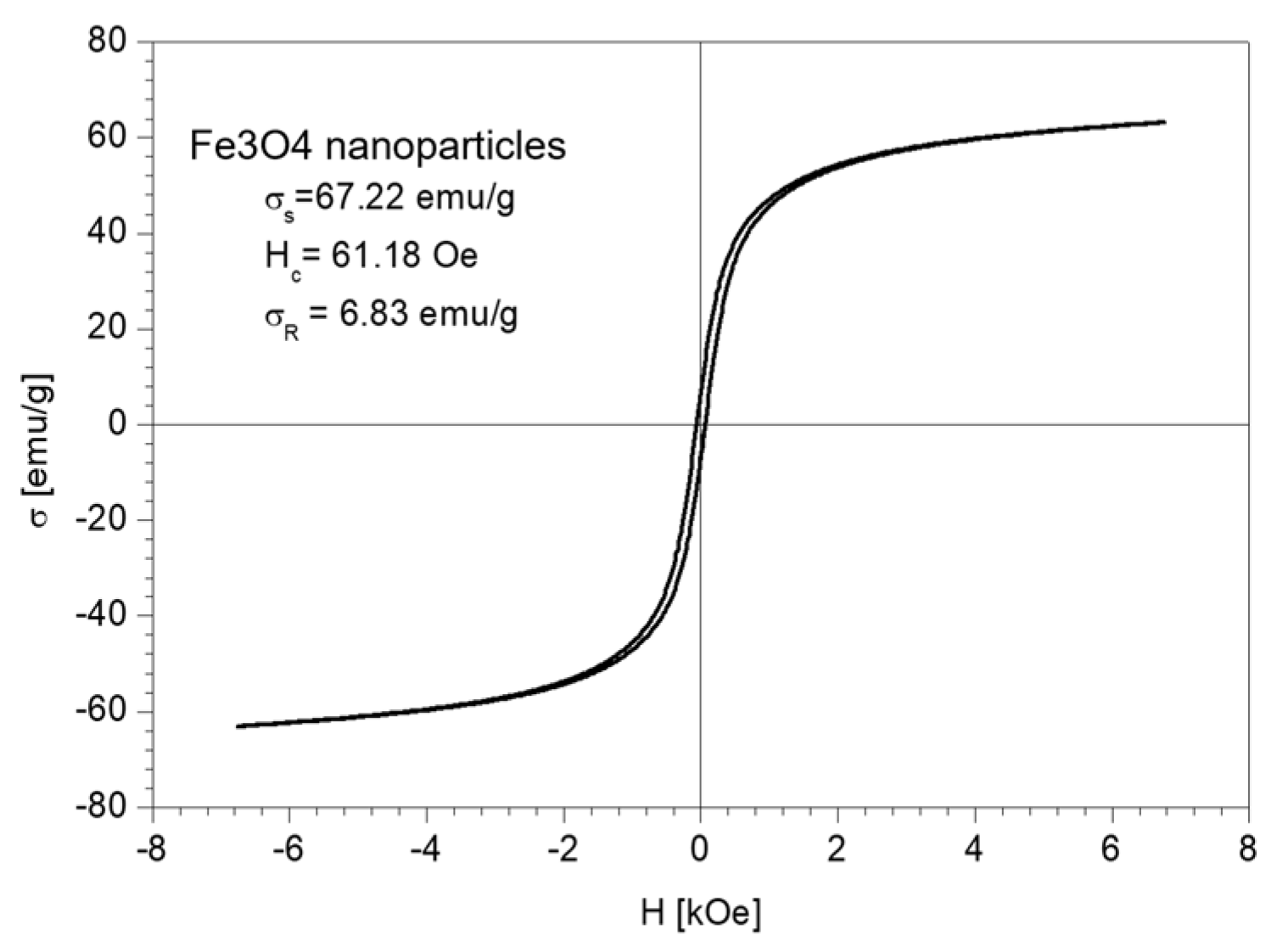

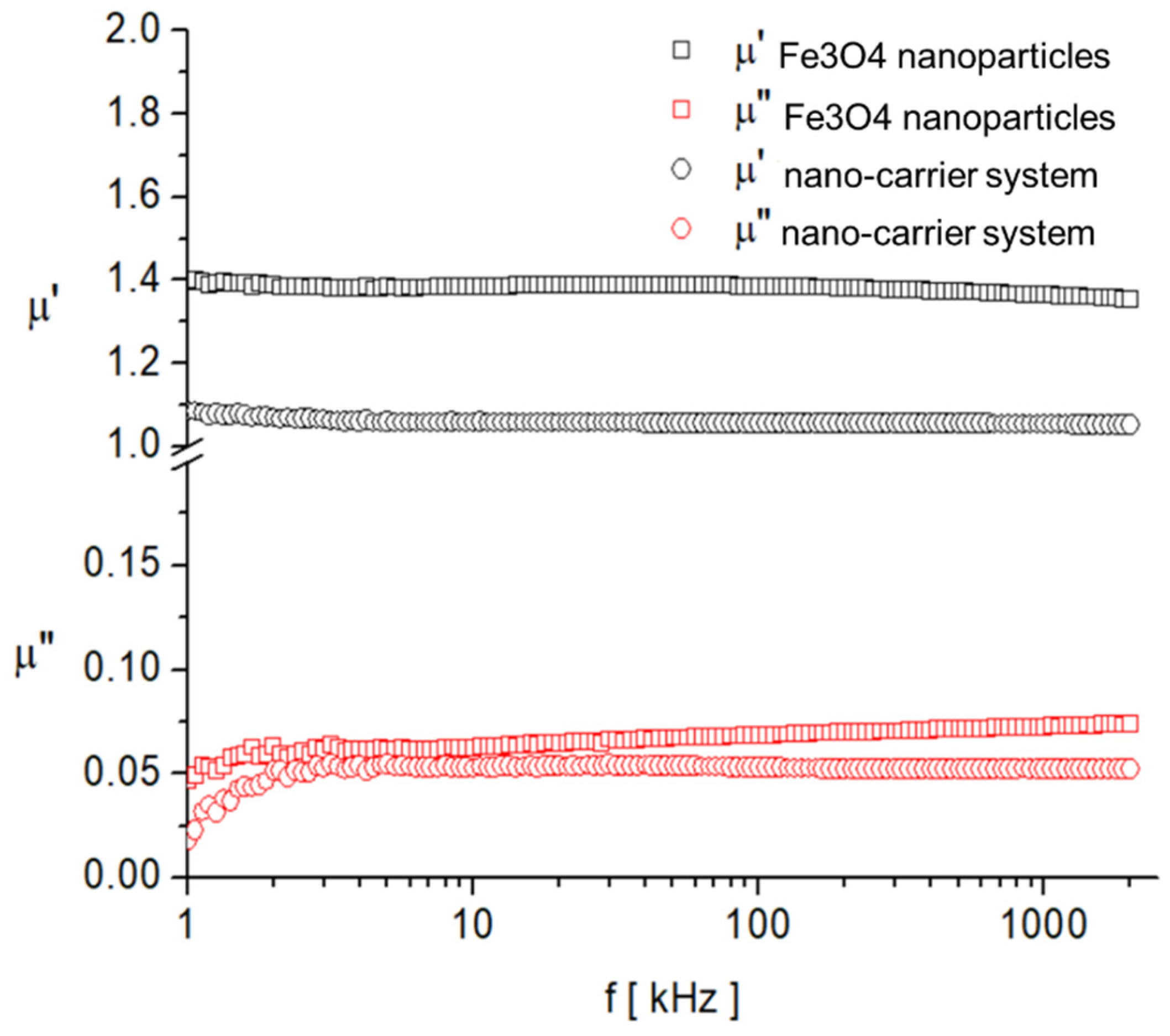
| Proposed Structure | Abbreviation | SIM (Selected Ion Monitoring) |
|---|---|---|
| Alanine | Ala | 130, 70 |
| Leucine | Leu | 172, 86 |
| Glycine | Gly | 116, 74 |
| Isoleucine | Ile | 172, 130 |
| Methionine | Met | 203, 277 |
| Phenylalanine | Phe | 206, 190 |
| Lysine | Lys | 170, 128 |
| Threonine | Thr | 160, 101 |
| 4-Hydroxyproline | HYP | 172, 86 |
| Compound Name | m/z Detected | Theoretic m/z | Formula | Tentative Identification | References |
|---|---|---|---|---|---|
| 1 | 76.09 | 76.07 | C2H5NO2+ | Glycine | [32,61] |
| 2 | 90.11 | 90.097 | C3H7O2+ | Alanine | [32,61] |
| 3 | 103.19 | 103.17 | C6H14O+ | Hexanol | [7,8,10,18,23,28,33,36,37,62] |
| 4 | 106.12 | 106.09 | C3H7NO3+ | Serine | [32,61] |
| 5 | 113.10 | 113.09 | C4H4N2O2+ | Uracil | [7,8,10,18,24,30,35,38,39,61] |
| 6 | 118.13 | 118.14 | C5H11NO2+ | Valine | [32,61] |
| 7 | 120.05 | 120.03 | C4H9NO3+ | Threonine | [32,61] |
| 8 | 129.23 | 129.21 | C8H16O+ | Caprylaldehyde | [7,8,18,23,28,32,36,37,62] |
| 9 | 132.14 | 132.13 | C5H9NO3+ | l-hydroxyproline | [32,61] |
| 10 | 132.17 | 132.18 | C6H13NO2+ | Leucine | [32,61] |
| 11 | 134.09 | 134.10 | C4H7NO4+ | Aspartic acid | [32,61] |
| 12 | 135.23 | 135.22 | C10H14+ | p-Cymene | [63] |
| 13 | 136.21 | 136.19 | C7H5NS+ | Benzothiazole | [7,8] |
| 14 | 137.25 | 137.23 | C10H16+ | Limonene | [9,10,11,12,14,19,20,22,23,46,52,59,63,64,65] |
| 15 | 139.15 | 139.12 | C7H6O3+ | Salicylic acid | [7,8,9,18,23,28,33,36,37,62] |
| 16 | 147.16 | 147.14 | C9H6O2+ | Coumarin | [9,10,11,12,14,19,20,22,23,46,52,59,60,63,64] |
| 17 | 147.20 | 147.19 | C6H14N2O2+ | Lysine | [32,61] |
| 18 | 148.12 | 148.13 | C5H9NO4+ | Glutamic acid | [32,61] |
| 19 | 149.21 | 149.205 | C10H12O+ | 4-Isopropylbenzaldehyde | [7,8,18,23,28,33,36,37] |
| 20 | 150.22 | 150.20 | C6H11NO2S+ | Methionine | [32,61] |
| 21 | 151.19 | 151.22 | C10H14O+ | Cuminol | [7,8,18,23,28,33,36,37,62] |
| 22 | 153.25 | 153.233 | C10H16+ | Artemisia ketone | [5,6,7,9,11,12,13,14,16,19,20,21,22,23,35,46,58,59,60,63,65] |
| 23 | 155.23 | 155.21 | C12H10+ | Capillene | [7,8,18,23,28,33,36,37,62] |
| 24 | 155.27 | 155.25 | C10H18O+ | Geraniol | [9,10,11,12,14,19,20,22,23,46,52,59,61,63,64] |
| 25 | 156.17 | 156.16 | C6H9N3O2+ | Histidine | [32,61] |
| 26 | 157.29 | 157.26 | C10H20O+ | Menthol | [9,10,11,12,14,19,20,22,23,46,52,59,63,64,66] |
| 27 | 162.15 | 162.13 | C9H5O3+ | 4-Hydroxycoumarin | [7,8,10,18,23,28,33,36,37,62] |
| 28 | 165.19 | 165.16 | C9H8O3+ | 4-Hydroxycinnamic acid | [7,8,10,18,23,28,33,36,37,62] |
| 29 | 165.18 | 165.20 | C10H12O2+ | Eugenol | [9,10,11,12,14,19,20,22,23,46,52,59,63,64,66] |
| 30 | 166.22 | 166.19 | C9H11NO2+ | l-phenylalanine | [32,61] |
| 31 | 171.29 | 171.33 | C12H26+ | Dodecane | [7,8,18,23,28,33,36,37,62] |
| 32 | 175.19 | 175.20 | C6H14N4O2+ | l-arginine | [32,61] |
| 33 | 181.17 | 181.16 | C9H8O4+ | Caffeic acid | [7,8,18,23,28,33,36,37,62] |
| 34 | 183.19 | 183.17 | C9H10O4+ | 2,4-Dihydroxy-6 methoxyacetophenone | [7,8,18,23,28,33,35,37] |
| 35 | 193.15 | 193.17 | C10H8O4+ | Scopoletin | [9,10,11,12,14,19,20,22,23,46,52,59,63,64,66] |
| 36 | 197.21 | 197.20 | C10H12O4+ | Xanthoxylin | [7,8,18,23,28,33,36,37,62] |
| 37 | 197.30 | 197.29 | C12H20O2+ | Artemisyl acetate | [5,6,7,9,11,12,13,14,16,19,20,21,22,35,46,58,59,60,63,65] |
| 38 | 207.21 | 207.19 | C11H10O4+ | Scoparone | [9,10,11,12,14,19,20,22,23,46,52,58,63,64,66] |
| 39 | 205.33 | 205.35 | C15H24+ | Germacrene D | [9,10,11,12,14,19,20,22,23,46,52,58,63,64,66] |
| 40 | 207.39 | 207.37 | C15H26+ | Cadinene | [9,10,11,12,14,19,20,22,23,46,52,58,63,64,66] |
| 41 | 220.23 | 220.24 | C10H13N5O+ | Zeatin | [7,8,18,23,28,33,36,37,62] |
| 42 | 221.36 | 221.35 | C15H24O+ | Spathulenol | [9,10,11,12,14,19,20,22,23,46,52,58,63,64,66] |
| 43 | 223.38 | 223.37 | C15H26O+ | Farnesol | [9,10,11,12,14,19,20,22,23,46,52,58,63,64,66] |
| 44 | 229.35 | 229.37 | C14H28O2+ | Myristic acid | [7,8,18,23,28,33,36,37,62] |
| 45 | 233.30 | 233.32 | C15H20O2+ | Alantolactone | [64] |
| 46 | 235.29 | 235.33 | C15H22O2+ | Artemisinic acid | [5,6,7,9,11,12,13,14,16,19,20,21,22,35,46,58,59,60,63,65] |
| 47 | 237.37 | 237.35 | C15H24O2+ | Corymbolone | [9,10,11,12,14,19,20,22,23,46,52,59,63,64,66] |
| 48 | 246.33 | 246.32 | C15H19NO2+ | Rupestine | [9,10,11,12,14,19,20,22,23,46,52,59,63,64,66] |
| 49 | 265.31 | 265.32 | C15H20O4+ | Abscisic acid | [5,6,7,9,11,12,13,14,16,19,20,21,22,35,46,58,59,60,63,65] |
| 50 | 241.48 | 241.5 | C17H36+ | Heptadecane | [7,8,18,23,28,33,36,37,62] |
| 51 | 247.29 | 247.30 | C15H18O3+ | α-Santonin | [64] |
| 52 | 249.30 | 249.32 | C15H20O3+ | Arteannuin B | [5,6,7,9,11,12,13,14,16,19,20,21,22,35,46,58,59,60,63,65] |
| 53 | 255.35 | 255.5 | C18H38+ | n-Octadecane | [7,8,18,23,28,33,36,37,62] |
| 54 | 257.43 | 257.42 | C16H32O2+ | Palmitic acid | [7,8,18,23,28,33,36,37,62] |
| 55 | 263.42 | 263.40 | C17H26O2+ | α-Bergamotol acetate | [7,8,18,23,28,33,36,37,62] |
| 56 | 267.30 | 267.33 | C15H22O4+ | Germacranolide | [64] |
| 57 | 271.39 | 271.40 | C15H10O5+ | Apigenin | [56,57,58,59,60,67,68,69,70,71] |
| 58 | 273.27 | 273.25 | C15H12O5+ | Naringenin | [56,57,58,59,60,67,68,69,70,71] |
| 59 | 281.34 | 281.32 | C15H20O5+ | Artemisitene | [5,6,7,9,11,12,13,14,16,19,20,21,22,35,46,58,59,60,63,65] |
| 60 | 283.34 | 283.33 | C15H22O5+ | Artemisinine | [5,6,7,9,11,12,13,14,16,19,20,21,22,35,46,58,59,60,63,65] |
| 61 | 285.27 | 285.26 | C16H12O5+ | Acacetin | [56,57,58,59,60,67,68,69,70,71] |
| 62 | 287.26 | 287.24 | C15H10O6+ | Luteolin | [56,57,58,59,60,67,68,69,70,71] |
| 63 | 289.27 | 289.25 | C15H12O6+ | Eriodyctiol | [56,57,58,59,60,67,68,69,70,71] |
| 64 | 297.51 | 297.50 | C20H40O+ | Phytol | [9,10,11,12,14,19,20,22,23,46,52,59,63,64,66] |
| 65 | 301.28 | 301.26 | C16H12O6+ | Rhamnocitrin | [56,57,58,59,60,67,68,69,70,71] |
| 66 | 303.21 | 303.23 | C15H10O7+ | Quercetin | [56,57,58,59,60,68,69] |
| 67 | 305.22 | 305.25 | C15H12O7+ | Taxifolin | [56,57,58,59,60,64,67,68,69,70,71] |
| 68 | 315.31 | 315.29 | C17H14O6+ | Cirsimaritin | [56,57,58,59,60,64,67,68,69,70,71] |
| 69 | 317.24 | 317.26 | C16H12O7+ | Rhamnetin | [56,57,58,59,60,67,68,69,70,71] |
| 70 | 317.37 | 317.40 | C19H24O4+ | Capillartemisin B | [56,57,58,59,60,64] |
| 71 | 319.20 | 319.23 | C15H10O8+ | Quercetagetin | [56,57,58,59,60,64,67,68,69,70,71] |
| 72 | 324.57 | 324.60 | C22H44O+ | 2-Docosanone | [7,8,18,23,28,33,36,37,62] |
| 73 | 331.26 | 331.29 | C17H14O7+ | Rhamnazin | [56,57,58,59,60,64,67,68,69,70,71] |
| 74 | 333.24 | 333.26 | C16H12O8+ | Laricitrin | [56,57,58,59,60,64,67,68,69,70,71] |
| 75 | 339.67 | 339.70 | C24H50+ | n-Tetracosane | [7,8,18,23,28,33,36,37,62] |
| 76 | 345.32 | 345.30 | C18H16O7+ | Eupatorine | [56,57,58,59,60,64,67,68,69,70,71] |
| 77 | 347.27 | 347.30 | C17H14O8+ | Syringetin | [56,57,58,59,60,64,67,68,69,70,71] |
| 78 | 353.68 | 353.70 | C25H52+ | n-Pentacosane | [7,8,18,23,28,33,36,37,62] |
| 79 | 354.29 | 354.31 | C16H18O9+ | Scopoline | [9,10,11,12,14,19,20,22,23,46,52,59,63,64,66] |
| 80 | 359.31 | 359.30 | C19H18O7+ | Retusin | [56,57,58,59,60,64,67,68,69,70,71] |
| 81 | 361.33 | 361.30 | C18H16O8+ | Chrysosplenol D | [56,57,58,59,60,64,67,68,69,70,71] |
| 82 | 367.71 | 367.7 | C26H54+ | n-Hexacosane | [7,8,18,23,28,33,36,37,62] |
| 83 | 375.28 | 375.30 | C19H18O8+ | Chrysosplenetin | [56,57,58,59,60,64,67,68,69,70,71] |
| 84 | 389.39 | 389.40 | C20H20O8+ | Artemitin | [9,16,17,21,23,56,57,58,59,60,65] |
| 85 | 375.28 | 375.30 | C19H18O8+ | Casticin | [56,57,58,59,60,64,67,68,69,70,71] |
| 86 | 377.41 | 377.40 | C20H24O7+ | Euparotin | [56,57,58,59,60] |
| 87 | 411.68 | 411.70 | C30H50+ | Squalene | [9,10,11,12,14,19,20,22,23,46,52,59,63,64,66] |
| 88 | 413.72 | 413.70 | C29H48O+ | Stigmasterol | [7,8,18,24,30,35,38,39] |
| 89 | 415.67 | 415.70 | C29H50O+ | β-Sitosterol | [7,8,18,23,28,33,36,37,62] |
| 90 | 425.69 | 425.70 | C30H48O+ | Taraxasterone | [9,10,11,12,14,19,20,22,23,46,52,59,63,64,66] |
| 91 | 427.71 | 427.70 | C30H50O+ | Beta-amyrin | [9,10,11,12,14,19,20,22,23,46,52,59,63,64,66] |
| 92 | 433.37 | 433.40 | C21H20O10+ | Apigenin 7-O-glucoside | [64] |
| 94 | 443.52 | 443.50 | C25H30O7+ | Tomentin A | [9,10,11,12,14,19,20,22,23,46,52,59,63,64,66] |
| 95 | 447.38 | 447.40 | C22H22O10+ | Kaempferide 3-rhamnoside | [57] |
| 96 | 449.37 | 449.40 | C21H20O11+ | Cymaroside | [56,57,58,59,60,64,67,68,69,70,71] |
| 97 | 457.71 | 457.70 | C30H48O3+ | Oleanic acid | [7,8,18,22,27,31,34,35,60] |
| 98 | 465.38 | 465.40 | C21H20O12+ | Isoquercetin | [56,57,58,59,60,64,67,68,69,70,71] |
| 99 | 495.43 | 495.40 | C22H22O13+ | Patuletin 3-glucoside | [64] |
| 100 | 505.37 | 505.40 | C18H32O16+ | Sophorotriose | [64] |
| 101 | 517.42 | 517.40 | C25H24O12+ | Cynarine | [7,8,18,22,27,31,34,35,60] |
| 102 | 577.77 | 577.80 | C35H60O6+ | Daucosterol | [7,8,18,22,27,31,34,35,60] |
| 103 | 611.51 | 611.50 | C27H30O16+ | Rutin | [56,57,58,59,60,64,67,68,69,70,71,72] |
| Chemical Class | Metabolite Name |
|---|---|
| Amino Acids | Glycine |
| Alanine | |
| Serine | |
| Valine | |
| Threonine | |
| l-hydroxyproline | |
| Leucine | |
| Aspartic acid | |
| Lysine | |
| Glutamic acid | |
| Methionine | |
| Hystidine | |
| l-phenylalanine | |
| l-arginine | |
| Terpenoids and Sesquiterpenoids | Artemisine |
| Artemisinine | |
| Limonele | |
| p-Cymene | |
| Beta-amyrin | |
| Artesimic acid | |
| Eugenol | |
| Menthol | |
| Artemisia ketone | |
| Spathulenol | |
| Artemisyl acetate | |
| Artemisinic acid | |
| Phytol | |
| Rupestine | |
| α-Santonin | |
| Arteannuin B | |
| Farnesol | |
| Corymbolone | |
| Abscisic acid | |
| Alantolactone | |
| Artemisitene | |
| Geraniol | |
| Squalene | |
| Taraxasterone | |
| Beta-amyrin | |
| Germacranolide | |
| Germacrene D | |
| Cadinene | |
| Coumarins | Scopoletin |
| Tomentin A | |
| Coumarin | |
| Scopolin | |
| Scoparone | |
| Flavonoids | Apigenin |
| Chrysosplenetin | |
| Rhamnazin | |
| Luteolin | |
| Naringenin | |
| Capillartemisin B | |
| Rutin | |
| Quercetin | |
| Quercetagetin | |
| Acacetin | |
| Rhamnetin | |
| Eupatorin | |
| Syringetin | |
| Laricitrin | |
| Eriodictiol | |
| Casticin | |
| Chrysosplenol D | |
| Retusin | |
| Cynaroside | |
| Artemitin | |
| Taxifolin | |
| Isoquercetin | |
| Rhamnocitrin | |
| Kaempferide 3-rhamnoside | |
| Cirsimaritin | |
| Phenolic Acids | 4-Hydroxycoumarin |
| 4-Hydroxycinnamic acid | |
| Caffeic acid | |
| Sterol and Steroids | β-Sitosterol |
| Stigmasterol | |
| Daucosterol | |
| Fatty Acid | Oleanic acid |
| Palmitic acid | |
| Myristic acid | |
| Hydrocarbons | n-Octadecane |
| Heptadecane | |
| n-Tetracosane | |
| n-Hexacosane | |
| Dodecane | |
| n-Pentacosane | |
| Capillene | |
| Glycoside | Patuletin 3-glucoside |
| Apigenin 7-O-glucoside | |
| Carbohydrates | Sophorotriose |
| Aldehyde and Ketone | Caprylaldehyde |
| 4-Isopropylbenzaldehyde | |
| Hexanol | |
| 2-Docosanone | |
| 2,4-Dihydroxy-6-methoxyacetophenone | |
| Organic Acids and Esters | Salicylic acid |
| α-Bergamotol acetate | |
| Xanthoxylin | |
| Cynarine | |
| Other | Uracil |
| Cuminol | |
| Benzothiazole | |
| Zeatin |
| Sample | σS (emu/g) | HC (Oe) | σR (emu/g) |
|---|---|---|---|
| Fe3O4 nanoparticles | 67.22 | 61.18 | 6.83 |
| Nano-carrier system | 27.17 | 82.10 | 2.77 |
Publisher’s Note: MDPI stays neutral with regard to jurisdictional claims in published maps and institutional affiliations. |
© 2021 by the authors. Licensee MDPI, Basel, Switzerland. This article is an open access article distributed under the terms and conditions of the Creative Commons Attribution (CC BY) license (https://creativecommons.org/licenses/by/4.0/).
Share and Cite
Segneanu, A.-E.; Marin, C.N.; Ghirlea, I.O.-F.; Feier, C.V.I.; Muntean, C.; Grozescu, I. Artemisia annua Growing Wild in Romania—A Metabolite Profile Approach to Target a Drug Delivery System Based on Magnetite Nanoparticles. Plants 2021, 10, 2245. https://doi.org/10.3390/plants10112245
Segneanu A-E, Marin CN, Ghirlea IO-F, Feier CVI, Muntean C, Grozescu I. Artemisia annua Growing Wild in Romania—A Metabolite Profile Approach to Target a Drug Delivery System Based on Magnetite Nanoparticles. Plants. 2021; 10(11):2245. https://doi.org/10.3390/plants10112245
Chicago/Turabian StyleSegneanu, Adina-Elena, Catalin Nicolae Marin, Ioan Ovidiu-Florin Ghirlea, Catalin Vladut Ionut Feier, Cornelia Muntean, and Ioan Grozescu. 2021. "Artemisia annua Growing Wild in Romania—A Metabolite Profile Approach to Target a Drug Delivery System Based on Magnetite Nanoparticles" Plants 10, no. 11: 2245. https://doi.org/10.3390/plants10112245





